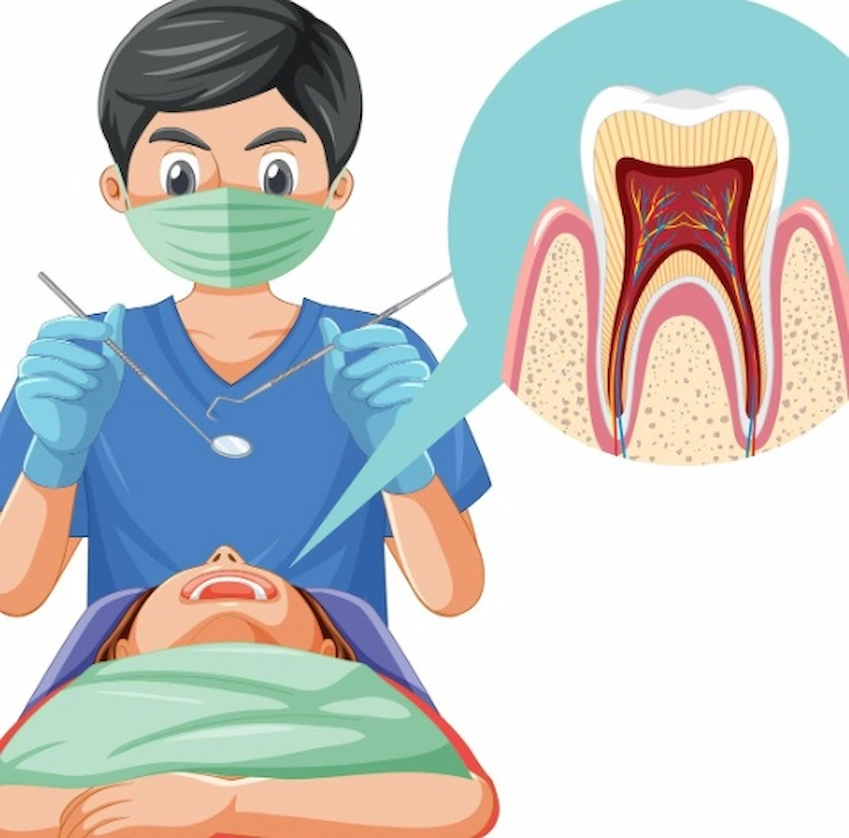🦷How To Stop And Managing Throbbing Pain After Root Canal?

A root canal procedure with throbbing pain is indeed a disturbing experience. Therefore, effectively managing this uncomfortable situation is of great importance to the patient who faces such a challenge. The very first and most vital step is to reach out to your oral health care expert so you can talk about the way you are feeling and about how much pain you have been in.
Your dental care expert might prescribe some effective pain medication to relieve the pain or modify the treatment given to you in a way that will help reduce the throbbing pain you are suffering from. Also, for more effective recovery, it’s very important to properly follow the postoperative advice given by your doctor’s office, quit hard physical exercises, limit the physical activity performed, and remove the source of discomfort.
What Mainly Causes Pain After A Root Canal?
When patients undergo a root canal, some report feeling pain and other discomforts. While unpleasant, the presence of this discomfort is generally considered normal due to the healing processes of the human body. The main reason for this pain during the procedure is the dentist’s actions in the infected and damaged tissues, causing an inherent inflammatory response. A certain level of aching pain can be expected with the condition that it is temporary and, therefore, in due time, decreases. Abiding by the prescription of the doctor and attending regular follow-ups are quite crucial to properly prevent and address the above pain.
Is It Normal to Have Pain after a Root Canal?
Even though there is a lot to deal with after having one, a person experiencing a root canal may notice throbbing pain around the spot where the work was done. A thundering ache following a root canal is an indication of the body starting to mend itself, as this method does take note of the condition area.
An enormous factor in the level of pain and duration could be the degree of a person’s immunity, healing powers, and pain resistance. If the pain gets more severe than you think could be tolerated or shows no signs of improvement for a length of more than 3 days, you must contact your dentist or a dentist immediately. I believe he can tell you whether you have a case or any other problems like those pointed out in the previous paragraph, and they are to be taken care of.
Possible Reasons for Severe Pain after a Root Canal
It is possible to experience discomfort after the root canal treatment. Many conditions may be the likely causes of this pain, but not only since they may be characterized due to the patient’s or dentist’s unprofessional act or the useful and inappropriate methods. This pain is caused by the surrounding area and the tooth processes of regeneration that may enhance the sensitivity of the nerves. Furthermore, something in the injured area may have been potentially harmed (and wasn’t during endodontic therapy). And here are the common causes of pain after endodontic treatment maintenance:
- Inflammation
- Infection
- Irritation of nerves
- Healing response
- Pressure from dental work
How Long Does Pain Last After a Root Canal?
When it comes to the length of time that discomfort may occur after the root canal treatment, it varies greatly between individual patients. A general perception is that patients may experience discomfort ranging from just a few days to up to a week after the procedure. A vast number of people who get root canals usually report noticeable relief after the end of some 48 hours.
It is very important to note that the length of time that your dental procedure should last may be affected by several factors. These may include the pre-existing condition of the tooth before treatment and the extent to which the patient tolerates pain. Thus, it is important for dental patients to strictly follow their dentists’ guidelines during the recovery time to facilitate proper healing.
Typical Recovery Timeline
Oral surgery, like root canal therapy, demands a definite recovery time. Usually, the period stretches for up to two days, when it is most painful. Then, as time goes on within the first week, the pain should begin to decline. The good news for those who can withstand pain is that immediately after the commencement of this second week, normal life can be resumed. Although some patients may take slightly longer, overall recovery may take from the second to the third week before one achieves optimal healing, making it advisable to find a measure of self-patience along the recovery route.
Factors That Can Prolong Pain
Some of the prolonged periods of pain after a root canal can be attributed to various factors in the process of recovering from the dental procedure. One of the factors that may lead to an extended pain episode in dental patients is the complexity of the procedure. Before selecting the procedure, one needs to take into account the complications that may arise if any pre-existing conditions exist in the patient.
Secondly, if aftercare is not done as instructed, recovery will be hindered; hence, chronic pain is likely to occur. Some patients may find it difficult to stick to the supposed dietary recommendations for the first days after surgery. However, putting into consideration the educational information aimed at reducing post-operative infections and ensuring the patient minimizes stress, will hasten healing as well as enhance one’s recovery.
Immediate Remedies to Alleviate the Unbearable Throbbing Pain
After getting a root canal treatment, it’s not uncommon to experience some level of throbbing pain in the dental area. However, some immediate remedies can be quite helpful in relieving the discomfort you are feeling. Therefore, if you are looking for the best ways to relieve the aching feeling in that area, see the few recommendations provided below.
- Take over-the-counter pain medications that are sold in packs.
- Apply a cold compress to the area for about fifteen minutes.
- Begin using warm compresses after 48 hours.
- Take the time to keep your head elevated while resting on your bed.
- Avoid hard or chewy foods as much as possible.
Medications for Over-the-Counter Pain Relief
Over-the-counter pain medications are one of the best ways you can relieve yourself from throbbing pain for high-quality dental health. Most often, ibuprofen and acetaminophen are provided as the best recommended over-the-counter medications for the function of weight loss. So when you are suffering from discomfort, use these pills as instructed on the label, and don’t forget to hydrate yourself with water to be within the safe limits of these pills. In case the pain persists and doesn’t seem to alleviate even after taking the earlier-mentioned medications, then you are advised to seek the necessary medical assistance from your dentist.
Effectiveness of Cold and Warm Compresses
Another highly effective method of providing pain relief after dental surgery is the use of cold and warm compresses. First, you should start by applying a cold compress to the area, thus reducing swelling and numbing it. You can wrap a few ice cubes in a clean towel or use an ice pack for the soreness in the teeth that are not yet numb and sore.
Once the 48 hours have passed, one could graduate to the more suitable warm compresses for the area. Unlike cold compresses, warm compresses would improve blood circulation on the surface of the skin, help and keep the area warm, and thus ease the staples. Apply the cold and warm compresses for a period of 15 to 20 minutes for the best results, and take breaks in between using them.
The Importance of Keeping Your Head Elevated
Another great idea is to ensure that whenever you are lying down or expecting to sleep, you always keep your head elevated, which helps reduce the throbbing pain after a root canal. Nevertheless, as a result, blood circulation is highly improved in the area, which leads to reduced pressure and pain; thus, it is beneficial to use two or more pillows to raise your head above your body.
This elevated position will make you more comfortable and allow the surrounding tissues to heal better during the first few days of the treatment. As you try to make yourself comfortable in bed, make sure that your head is slightly raised above your body so that you will not feel much pain when you are sleeping.
Avoiding Hard or Chewy Foods: Understanding the Importance for Your Recovery
After having a root canal procedure done, it is important to be careful about what you eat. This is especially true when it comes to very hard or chewy foods that will continue to put pressure on the already treated and sensitive tooth. Such pressure may cause the treated tooth, already prone to complications and sensitivities, to become increasingly painful after treatment.
Following this plan of soft food intake will minimize the danger of experiencing sharp pain or complications and create an environment conducive to healing. Examples of such foods are mashed potatoes, smoothies, and yogurt, among others. Take soft foods whose chewing is not necessary, but do not give up on food for weight maintenance and health during this period.
Home Remedies for Managing Post-Treatment Pain

Post root canal treatment pain can be unpleasant and troublesome to stay away from. Luckily, there exist home cures that could help alleviate the discomfort and therefore enhance the effectiveness of prescribed medicinal drugs. These natural remedies are easy to obtain and have worked well for many individuals undergoing this medical procedure. The following are some efficient remedies to consider that will assist you in healing both physically and emotionally through the complication process.
- The soothing effects of saltwater rinses
- Nurturing yourself with clove oil and its properties
- Herbal teas as a respite from pain
- Remembering to eat anti-inflammatory foods
- Maintaining good oral hygiene practice
Salt Water Rinses for Inflammation: Relieve Your Discomfort with This Simple Technique
One of the tried home cures is saltwater rinses to reduce the pain and discomfort you may experience after the root canal procedure. These flavored solutions are not only cheap and easy to make, but they have also been proven effective in cutting off extra mucus from your mouth while speeding up your recovery. To do a saltwater rinse, simply mix ½ a teaspoon of salt into a standard glass of warm water.
This is achieved easily by careful stirring until it dissolves. Take a small volume of this solution into your mouth, keeping it there for some while before swishing it and releasing it gently without any sign of rush or disturbance. It is recommended that this practice be done 3 to 4 times within the day and when symptoms or discomfort are more intense. Repeatedly using saltwater rinses will give minimal but effective relief.
Clove Oil for Natural Pain Relief: The Secret Clove Oil Holds for Root Canal Patients
The clove is not just a spice; it is a powerful tool in pain management. This remarkable spice is rich in eugenol, a compound known for its analgesic and anti-inflammatory properties. In using clove oil as part of an overall strategy for pain control with reference to root canals, one can apply a moderate quantity of clove oil to a cotton ball or a similar item and then gently place it on the area around or near the tooth with a certain degree of massage. While this oil has great potency, it is worth noting that applying excessive pressure for over an
Herbal Teas and Anti-Inflammatory Foods
The use of herbal teas and anti-inflammatory foods possessing anti-inflammatory properties can support efficient pain management and provide relief after a root canal. Ginger and turmeric teas serve as the best herbal remedies, providing very soothing mildness, easing inflammation, and accelerating the healing process.
In addition, the huge consumption of foods such as raspberries, strawberries, blueberries, leafy greens, green vegetables, and nuts in your daily diet will naturally heal and promote the restoration of tissues, and lessen the swelling around the incident area. Thus, indulging in these botanical remedies not only improves the immediate comfort outcomes but also actively enhances your entire recovery process. However, if you want to achieve more in your treatment, be advised to take these teas and foods consistently as part of a balanced diet and a healthy lifestyle throughout the recovery journey.
Symptoms of a Failed Root Canal
There are numerous symptoms of a failed root canal procedure, such as heightened pain, swelling, and the presence of infections after the procedure that mirror the ones experienced after the post-operative pain has healed. The most common indications of a root canal failure include cases of excruciating pain, visible swelling, and severe infection of the gums where a dentist has undertaken root canal therapy. The existence of an unusual, persistent bad taste or odor can be another noticeable symptom of a failed root canal that gets worse and increasingly debilitating.
Possibility of Failure in Endodontic Work: An Analysis of the Possible Setbacks

Although endodontic procedures are among the most ill-fated dental treatments, it is important to point out that there is a few chance that they can fail. One of the vital steps in maintaining good oral health to satisfy at all costs is to know the possible repercussions of such procedures on the teeth structures. The failure of an endodontic procedure can be directly causal to the persistence of a tooth infection or an insufficient filling in order to counter the action of the removing infectious process. When you notice any abnormalities that seem strange, it is wise to approach your dentist for a thorough examination, diagnosis, and prescription treatment.
In such instances where endodontic treatment does not deliver the desired results, it is essential to understand the approach your dentist may take in the provision of another course of action.
The first treatment option that he may recommend is a retreat procedure, wherein he will make incisions and remove previously used materials as he deals effectively with the cause of the failure. The other alternative would be an apicoectomy, a surgical operation meant to remove the root tip, to eliminate the cause of the aggravation. However, any treatment that would follow this option would be a last resort. If all the other alternatives have been tabled and all the issues of the tooth examined, the best option may be to remove the problematic tooth altogether and get information about tooth replacement options that may include bridges or dentures you can use to improve your smile once again.
Root Canal Treatment: FAQ’s
In adult dentistry, the term “root canal” refers to the intricate procedure that is used to return health to the inside of a tooth that has been through any kind of infection or decay and involves the delicate internal structure called “pulp”. You might consider this option if you have a serious toothache, extreme Wisdom teeth discomfort, etc, as a dentist will properly examine you and, if necessary, suggest this kind of treatment. To help you understand the root canal procedure, benefits, recovery, as well as clear many doubts regarding this process.
A root canal is a dental procedure that involves removing infected or damaged tissue from inside the tooth, specifically the pulp, and then sealing the space. This helps to preserve the tooth and prevent further infection.
Root canals are typically needed when the pulp of a tooth becomes infected due to deep decay, cracks, or injury. Symptoms include severe tooth pain, sensitivity to hot or cold, and swelling around the affected tooth.
While a root canal procedure is often associated with pain, modern techniques and local anesthesia ensure that the treatment is relatively pain-free. Some discomfort may occur after the procedure, but it is manageable with over-the-counter pain relievers.
The duration of a root canal can vary, but most procedures take about 1 to 2 hours. More complex cases may require additional appointments for complete treatment and restoration.
After a root canal, the tooth will be sealed, and a crown may be placed to restore its shape and function. While some discomfort is normal, the pain caused by infection should subside as the healing progresses.
Yes, root canal treatments are considered safe and highly effective. The procedure has been performed for decades with a high success rate, preserving the tooth and preventing the spread of infection.
Common signs that you may need a root canal include persistent tooth pain, heightened sensitivity to temperature, or a visible abscess near the tooth. Your dentist can diagnose the need for a root canal through X-rays and a clinical exam.
Although root canal treatments are highly successful, complications can arise, such as reinfection of the tooth. This may occur if the tooth is not adequately sealed or if bacteria enter the tooth after treatment.
The cost of a root canal varies depending on the location of the tooth, the complexity of the case, and the dentist’s office. On average, a root canal can range from $500 to $1,500 per tooth, excluding crowns or additional treatments.
While a root canal can save a tooth for many years, it does not guarantee permanent longevity. With proper care, a tooth treated with a root canal can last a lifetime, but it may require maintenance or restoration over time.




